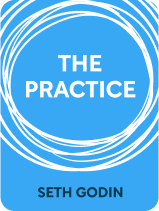

This article is an excerpt from the Shortform book guide to "The Practice" by Seth Godin. Shortform has the world's best summaries and analyses of books you should be reading.
Like this article? Sign up for a free trial here.
What is The Practice by Seth Godin about? What are the main takeaways of the book?
Seth Godin’s The Practice dismantles the long-standing myth that creativity requires a special kind of “magic.” Godin argues that making creative work doesn’t require genius, lightning bolts of inspiration, or even confidence.
Read below for a brief overview of The Practice by Seth Godin.
The Practice by Seth Godin
In The Practice, Seth Godin argues that, contrary to popular belief, creativity does not require that you be touched by the “muse.” It doesn’t require genius or suffering or even confidence. Instead, creativity is a skill that can be learned. To be a successful creative professional, you need to maintain a consistent practice that includes: making work that will effect change for the better, sharing that work with others, getting feedback, and making improvements.
Seth Godin is an entrepreneur, speaker, and author of 20 best-selling books, including Tribes, All Marketers Are Liars, and Purple Cow. The Practice is based on Godin’s online class, “The Creative’s Workshop,” which is offered through Akimbo, the education company he founded.
The Practice consists of 219 short lessons on creativity, loosely organized by theme. We’ve condensed many of Godin’s lessons to avoid repetition and reorganized them into four main principles:
- Principle 1: Learn to Trust Yourself
- Principle 2: Establish Your Intent
- Principle 3: Work Consistently Despite the Apparent Obstacles
- Principle 4: Share Your Work and Make Improvements
What Is the Practice?
In The Practice, Godin dismantles the myth that successful artists, writers, musicians, and other creatives were born with special talents and have access to a constant flow of inspiration from the “muses” of creativity. Godin argues that in fact, creativity is a skill that can be learned. How? By adopting “the practice”: the habit of consistently making and sharing creative work.
According to Godin, creativity is an action, not a feeling. If you want to create art of any kind, you don’t sit around waiting until you feel creative: You put in the work, day after day, and creativity follows. Committing to action can change how you feel, as well as change your beliefs about yourself. Identities like “writer” and “artist” aren’t innate; they’re a choice. If you want to be an artist, make art. You become what you do.
Godin defines art as something you get to do for others, to effect change for the better. In other words, creative work is founded on generosity and connection. He defines “shipping” (mentioned in the book’s subtitle: “Shipping Creative Work”) as sharing with others. To be a professional creative, as opposed to an amateur or a hobbyist, your work must be for someone besides yourself.
Principle 1: Learn to Trust Yourself
Godin’s lessons on creativity can be divided into four main principles, the first of which is: To do creative work, you have to trust yourself. Like creativity itself, this is a skill that can be learned.
Godin points out that you develop trust in others over time. The same is true for learning to trust yourself. If you engage in a practice of making creative work every day, while keeping the following considerations in mind, you’ll learn to trust that you can do the work.
Principle 2: Establish Your Intent (artistic intent)
In addition to learning to trust yourself, creative work requires that you establish your intent. If art seeks to make a change, then to make art you need to be clear on what change you’re trying to make. Godin argues that to be creative, you need to establish your intent by asking yourself what and who your work is for.
Principle 3: Work Consistently Despite Obstacles
While trusting yourself and establishing your intent are important to creative work, perhaps the most critical aspect of being a creative professional is working consistently despite the challenges that come your way. Godin advises that you spend at least an hour every day on your creative work. He takes the position that many of the apparent obstacles to producing good work—lack of inspiration, failure, and creative “blocks,” to name a few—are actually integral to your practice (or at the very least, they’re not the threat they’re often made out to be).
Principle 4: Share Your Work and Make Improvements
Godin believes it’s important to share your creative work regularly, on a schedule. Promising to deliver your work can help you be creative, and sharing your work allows you to receive feedback from your audience. Engaging with your audience is important because it will either give them something they want, or it will teach you what’s not working with what you created.

———End of Preview———
Like what you just read? Read the rest of the world's best book summary and analysis of Seth Godin's "The Practice" at Shortform.
Here's what you'll find in our full The Practice summary:
- Why creativity doesn't require any “magic”
- How creativity is a skill that anybody can learn
- Step-by-step lessons on how to be creative






